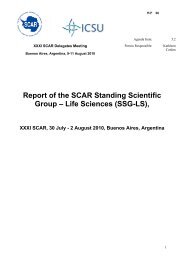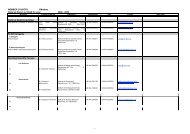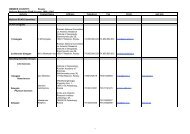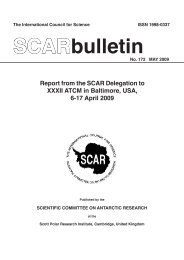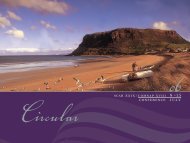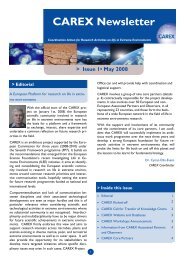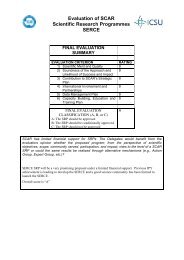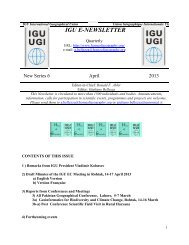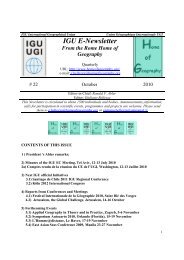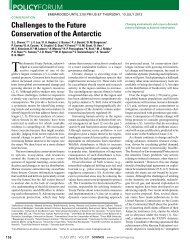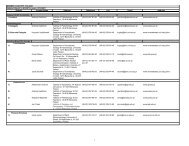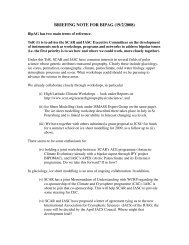SCAR Action Group History of Antarctic Research 1
SCAR Action Group History of Antarctic Research 1
SCAR Action Group History of Antarctic Research 1
You also want an ePaper? Increase the reach of your titles
YUMPU automatically turns print PDFs into web optimized ePapers that Google loves.
scientific internationalism participated in the organization <strong>of</strong> an International Polar<br />
Commission that was eclipsed by World War I. An effort to launch a new expedition<br />
jointly with British scientists also failed because <strong>of</strong> the war. While Norway was very<br />
active as a whaling nation around <strong>Antarctic</strong>a and eventually lay claim to what is now<br />
Dronning Maud Land, Swedish activities did not emerge again until 1948-1951 when a<br />
Norwegian-British-Swedish expedition (NBSX) spent a couple <strong>of</strong> winters at Cap<br />
Norwegia. This particular expedition, with significant science, has been referred to as<br />
the first example <strong>of</strong> a real internationalist effort. The inspiration came from the glaciologist<br />
Ahlman’s studies <strong>of</strong> aerial photographs taken by the German Schwabenland<br />
expedition in 1938/39. The Swedish glaciologist Walter Schytt who participated in the<br />
NBSX later served as the secretary <strong>of</strong> the Special Committee for <strong>Antarctic</strong> <strong>Research</strong><br />
that with its <strong>of</strong>fices in Stockholm, preceded <strong>SCAR</strong>. Paradoxically the Swedish government,<br />
owing to its emphasis on the Arctic during the Cold War period did not back up<br />
its scientists to follow up on this intitiative, and consequently Sweden never became a<br />
party to the club <strong>of</strong> founding members <strong>of</strong> the <strong>Antarctic</strong> Treaty Organization. It was not<br />
until the mid-1980s that interest in south polar research revived, mostly because it was<br />
feared that a re-evaluation <strong>of</strong> the ATO regime in 1991 might lead to the loss <strong>of</strong> a future<br />
window <strong>of</strong> opportunity (after 1991).<br />
The paper will probe the significance <strong>of</strong> scientific internationalism as an ethos embraced<br />
by scientific communities and its limitations in practice owing to the dependence on<br />
support from government and the concomitant ability to interplay at a level <strong>of</strong> intergovernmental<br />
organizations. It was on the successful interplay <strong>of</strong> non-governmental<br />
communities <strong>of</strong> science and state politics that the formation <strong>of</strong> the IGY and in its wake<br />
the ATO ultimately rested. Sweden as a promising player with a proven track record in<br />
science lost out for a number <strong>of</strong> reasons that will be discussed. Possible general requirements<br />
needed to realize international cooperative regimes for the development <strong>of</strong> new<br />
knowledge in polar regions will be highlighted.<br />
Wilhelm Filchner and <strong>Antarctic</strong>a<br />
Helmut Hornik 1 and Cornelia Lüdecke 2<br />
1 hornik@dgfi.badw.de, Filchner Archive at the Bavarian Academy <strong>of</strong> Sciences<br />
and Humanities, Munich, Germany<br />
2 C.Luedcke@lrz.uni-muenchen.de, Centre for the <strong>History</strong> <strong>of</strong> Science, Mathematics<br />
and Technology, University <strong>of</strong> Hamburg, Hamburg, Germany<br />
Wilhelm Filchner (*13.9.1877 Munich, †7.5.1957 Zurich), being a cadet in the military,<br />
used a three-month leave to undertake his spectacular ride over the Pamirs in 1900.<br />
In order to get a scientific basis for new expeditions he studied surveying, geography,<br />
and geophysics at various military and civil institutions. His next expedition led to<br />
North-East Tibet and Western China (1903-05) for carrying out Earth-magnetic measurements<br />
as well as mapping.<br />
For preparing an expedition to <strong>Antarctic</strong>a, Filchner had intensive contacts with Nordenskjöld,<br />
Shackleton, Nansen, and Neumayer. A test voyage to Spitsbergen was undertaken<br />
in 1910. The main island was crossed from Advent Bay to Wiche Bay. At the<br />
13



